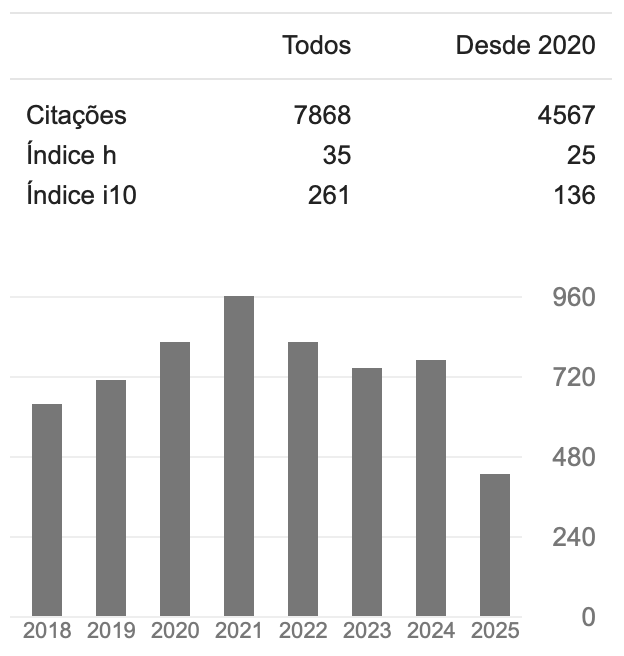Efeito do valor reforçador do alimento em diferentes tempos de privação alimentar
DOI:
https://doi.org/10.17765/1983-1870.2018v11n3p567-577Palavras-chave:
Motivação, Comportamento alimentar, Peso corporal, Privação de alimentosResumo
Avaliar o valor reforçador do alimento sob diferentes tempos de privação; até 4 horas (grupo tempo 1 - GT1) e mais de 4 horas (grupo tempo 2 - GT2), em mulheres e homens eutróficos e com excesso de peso, classificados pelo índice de massa corporal (IMC). Foram ouvidos 258 adultos, sendo 126 homens e 132 mulheres (18 - 50 anos), foram divididos em GT1 ou GT2. Após classificarem a fome pela escala analógica visual 100 mm, realizaram um jogo desenvolvido para este estudo (software Food or Fun 1.0), onde deveriam trabalhar para ganhar pontos em alimento ou lazer. Na amostra geral o relato de fome diferiu estatisticamente (p<0,001) entre GT1 (42,4 ± 25,9) e GT2 (60,2 ± 22,4) assim como a pontuação em alimentos (GT1=26,7 ± 23,5; GT2=35,2 ± 23,4; p<0,001), demonstrando uma tendência diretamente proporcional ao tempo de privação em ambos os sexos. Uma correlação negativa significativa foi encontrada entre IMC e pontos em alimentos para a amostra geral (r=-0,16; p=0,013) e do sexo feminino (r=-0,18; p=0,040). O valor reforçador do alimento aumentou concomitantemente com o tempo de privação e IMC apresentou uma correlação inversa à pontuação em alimentos.Downloads
Referências
NDC Risk Factor Collaboration (NDC-RisC). Trends in adult body-mass index in 200 countries from 1975 to 2014: a pooled analysis of 1698 population-based measurement studies with 19,2 million participants. Lancet. 2016;387:1377-96.
Meldrum DR, Morris MA, Gambone JC. Obesity pandemic: causes, consequences, and solutions-but do we have the will? Fertil Steril. 2017;107(4):833-9.
Hales CM, Fryar CD, Carroll MD. Trends in obesity and severe obesity prevalence in US youth and adults by sex and age, 2007-2008 to 2015-2016. JAMA. 2018;319(16):1723-5.
Ministério da Saúde (BR). Vigitel 2016: vigilância de fatores de risco e proteção para doenças crônicas por inquérito telefônico. Brasília: Ministério da Saúde; 2016.
Raynor HA, Epstein LH. The relative-reinforcing value of food under differing levels of food deprivation and restriction. Appetite. 2003;40:15-24.
Clifton PM, Condo D, Keogh JB. Long term weight maintenance after advice to consume low carbohydrate, higher protein diets – a systematic review and meta analysis. Nutr Metabol Cardiovasc Dis. 2014;24:224-35.
Schaumberg K, AndersonDA, AndersonLM, Reilly EE, Gorrell S. Dietary restraint: what´s the harm? A review of the relationship between dietary restraint, weight trajectory and development of eating pathology. Clin Obes. 2016;6:89-100.
Van Strien T, Herman CP, Verheijden MW. Dietary restraint and body mass change. A 3-year follow up study in a representative Dutch sample. Appetite. 2014;76:44-9.
Rolland C, Johnston KL, Lula S, Macdonald I, Broom J. Long-therm weight loss maintenance and management following a VLCD: a 3 years outcome. Int J Clin Pract. 2014;68:379-87.
Bueno LN, Nascimento NA. Transtornos alimentares sob a perspectiva da análise do comportamento. Fragmentos de Cultura. 2014;24:37-48.
Neves SMM, Santos AC, Araujo L, Borges R, Quinta T, Martins W. Obesidade e a Teoria de Determinação Skinneriana: correspondências de relatos de crianças. Comportamento em foco. 2011; 1:455-68.
Lazzeri F. Sobre o conceito de comportamento: alguns breves comentários. ReBAC. 2013;9(2):107-12.
Epstein LH, Lin H, Carr KA, Fletcher KD. Food reinforcement and obesity: psychological moderators. Appetite. 2012;58(1):157-62.
Carr KA, Lin H, Fletcher KD, Epstein LH. Food reinforcement, dietary disinhibition and weight gain in non-obese adults. Obes. 2014;22(1):254-9.
Drobes DJ, Miller EJ, Hillman CH, Bradley MM, Cuthbert BN, Lang PJ. Food deprivation and emotional reactions to food cues: implications for eating disorders. Biol Psychol. 2001;57:153-77.
Temple JL, Legierski CM, Giacomelli AM, Salvu SJ, Epstein LH. Overweight children find food more reinforcing and consume more energy than do nonoverweight children. Am J Clin Nutr.2008;87:1121-27.
McCullough MB, Guilkey H, Stark L. Cookie or fruit? Relative reinforcing value of snack foods among preschoolers with overweight/obesity compared to healthy weight. Appetite. 2017;111:187-94.
Clark EN, Dewey AM, Temple JL. Effects of daily snack food intake on food reinforcement depend on body mass index and energy density. Am J Clin Nutr. 2010;91:300-8.
Bobzean SA, DeNobrega AK, Perrotti LI. Sex differences in the neurobiology of drug addiction. Exp Neurol. 2014;259:64-74.
Dreher JC, Schmidt PJ, Kohn P, Furman D, Rubinow D, Berman KF. Menstrual cycle phase modulates reward-related neural function in women. Proc Natl Acad Sci U S A.2007;104:2465-70.
Lima, WF. Food or Fun (Versão 1.0) [Software]. Goiânia: Laboratório de Análise Experimental do Comportamento. 2016.
Catania AC. A natural science of behavior. Rev Gen Psychol. 2013;17(2):133-9.
Carr KA, Epstein LH. Influence of sedentary, social, and physical alternatives on food reinforcement. Health Psychol. 2018;37(2):125-31.
Hopkins, WG. Correlation coefficient. 2009. Disponível em: http://www.sportsci.org/resource/stats/correl.html Acessado em: 26 de junho de 2018.
Stice E, Burger K, Yokum S. Caloric deprivation increases responsivity of attention and reward brain regions to intake, anticipated intake, and images of palatable foods. Neuroimage. 2013;67:322-30.
Zitron-Emanuel N, Ganel T. The effect of food deprivation on human resolving power. Psychon Bull Rev. 2018;25(1):455-62.
Brace A, Yeomans MR. The reinforcing value of palatable snack foods and its relationship to subtypes of behavioural and self-report impulsivity. Eating Behaviors. 2016;21:18-23.
Carr KA, Lin H, Fletcher KD, Epstein LH. Food reinforcement, dietary disinhibition and weight gain in non-obese adults. Obesity. 2014;22(1):254-9.
Stojek MMK, MacKillop J. Relative reinforcing value of food and delay reward discounting in obesity and disordered eating: a systematic review. Clin Psychol Rev. 2017;55:1-11.
Epstein LH, Temple JL, Neaderhiser BJ, Salis RJ, Erbe RW, Leddy JJ. Food reinforcement, the dopamine D2 receptor genotype, and energy intake in obese and nonobese humans. Behavioral Neuroscience. 2007;121(5):877-86.
Santos AFS, Souza CSV, Oliveira LS, Freitas MFL. Influência da dopamina e seus receptores na gênese da obesidade: revisão sistemática. Rev Neurocienc. 2014;22(3):373-80.
Carr KD, Kim G, Cabeza de vaca S. Rewarding and locomotor-activating effects of direct dopamine receptor agonists are augmented by chronic food restriction in rats. Psychopharmacology. 2001;154:420-8.
Caravaggio F, Raitsin S, Gerretsen P, Nakajima S, Wilson A, Graff-Guerrero A. Ventral striatum binding of a dopamine D2/3 receptor agonist but not antagonist predicts normal body mass index. Biol Psychiatry. 2015;77(2):196-202.
Jimenez JJ. Leisure activities and hobbies preferred by third year college students. Asia Pacific Journal of Multidisciplinary Research. 2017;5(2):21-5.
Cameron JD, Goldfield GS, Riou ME, Finlayson GS, Blundell JE, Doucer E. Energy depletion by diet or aerobic exercise alone: Impact of energy déficit modality on appetite parameters. Am J Clin Nutr. 2016;103(4):1008-116.
Derous D, Mitchell SE, Green CL, Chen L, Han JJ, Wang Y, et al. The effects of graded levels of calorie restriction: VI. Impact of short-term graded calorie restriction on transcriptomic responses of the hypothalamic hunger and circadian signaling pathways. Aging. 2016;8(4):642-61.
Martens MJ, Born JM, Lemmens SG, Karhunen L, Heinecke A, Goebel R, Adam TC, Westerterp-Plantenga MS. Increased sensitivity to food cues in the fasted state and decreased inhibitory control in the satiated state in the overweight. Am J Clin Nutr. 2013;97:471-9.
Schoolet JW. Re-representing consciousness: Dissociations between consciousness and meta-consciousness. Trends Cogn Sci. 2002;6:339-44.
Perez W. Explicações comportamentais da correspondência dizer-fazer. ReBAC. 2017;13(1):16-28.
Creswell KG, Sayette MA, Schooler JW, Wright AGC, Pacilio LE. Visceral states call for visceral measures: verbal overshadowing of hunger ratings across assessment modalities. Assessment. 2016;25(2):173-82.
Saper CB, Chou TC, Elmquist JK. The need to feed: Homeostatic and hedonic control of eating. Neuron. 2002;36(2):199–211.
Giesen JCAH, Havermans RC, Douven A, Takelenburg M, Jansen A. Will work for snack food: the association of BMI and snack reinforcement. Obesity. 2010;18(5):966-70.
Downloads
Publicado
Como Citar
Edição
Seção
Licença
A submissão de originais para a revista Saúde e Pesquisa implica na transferência da Carta Concessão de Direitos Autorais, pelos autores, dos direitos de publicação digital para a revista após serem informados do aceite de publicação.A Secretaria Editorial irá fornecer da um modelo de Carta de Concessão de Direitos Autorais, indicando o cumprimento integral de princípios éticos e legislação específica. Os direitos autorais dos artigos publicados nesta revista são de direito do autor, com direitos da revista sobre a primeira publicação. Os autores somente poderão utilizar os mesmos resultados em outras publicações, indicando claramente a revista Saúde e Pesquisa como o meio da publicação original. Em virtude de tratar-se de um periódico de acesso aberto, é permitido o uso gratuito dos artigos, principalmente em aplicações educacionais e científicas, desde que citada a fonte. A Saúde e Pesquisa adota a licença Creative Commons Attribution 4.0 International.
A revista se reserva o direito de efetuar, nos originais, alterações de ordem normativa, ortográfica e gramatical, com vistas a manter o padrão culto da língua e a credibilidade do veículo. Respeitará, no entanto, o estilo de escrever dos autores. Alterações, correções ou sugestões de ordem conceitual serão encaminhadas aos autores, quando necessário. Nesses casos, os artigos, depois de adequados, deverão ser submetidos a nova apreciação. As opiniões emitidas pelos autores dos artigos são de sua exclusiva responsabilidade.


















